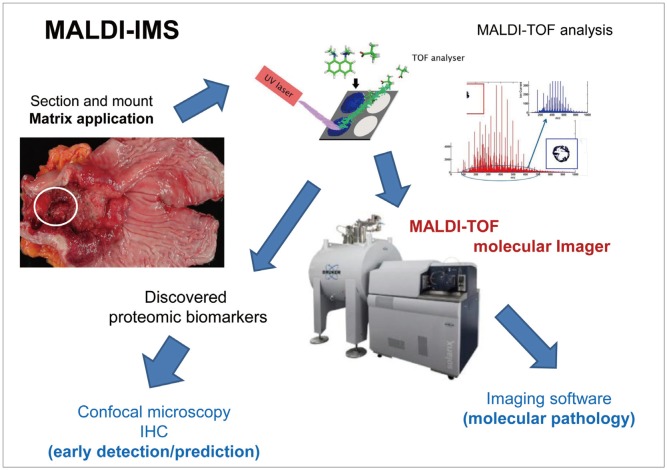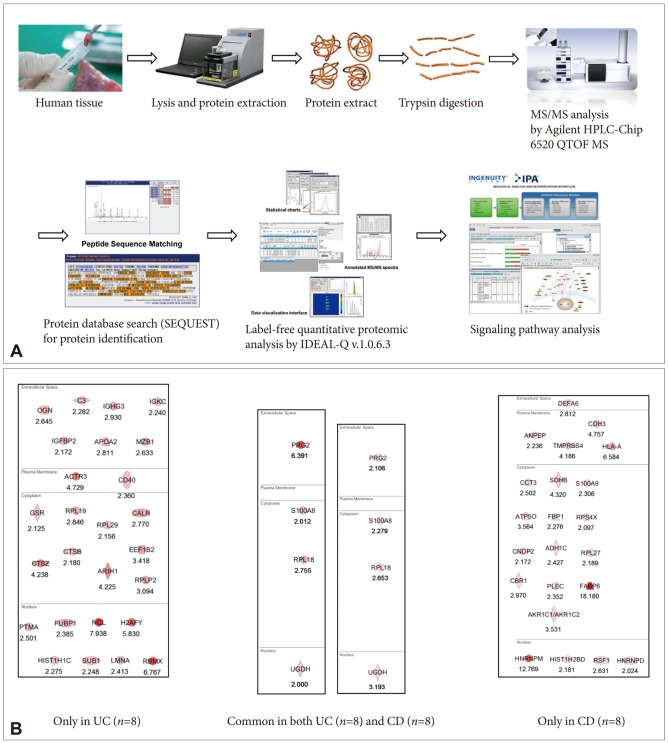1. Yeo M, Kim DK, Park HJ, et al. Loss of transgelin in repeated bouts of ulcerative colitis-induced colon carcinogenesis. Proteomics. 2006; 6:1158–1165. PMID:
16402363.

2. Goetz M, Malek NP, Kiesslich R. Microscopic imaging in endoscopy: endomicroscopy and endocytoscopy. Nat Rev Gastroenterol Hepatol. 2013; 7. 30. Epub. DOI:
10.1038/nrgastro.2013.134.

3. Goetz M, Watson A, Kiesslich R. Confocal laser endomicroscopy in gastrointestinal diseases. J Biophotonics. 2011; 4:498–508. PMID:
21567975.

4. Alexandrov T. MALDI imaging mass spectrometry: statistical data analysis and current computational challenges. BMC Bioinformatics. 2012; 13(Suppl 16):S11. PMID:
23176142.

5. Ghafourian S, Sekawi Z, Raftari M, Ali MS. Application of proteomics in lab diagnosis. Clin Lab. 2013; 59:465–474. PMID:
23865343.

6. Tabb DL. Quality assessment for clinical proteomics. Clin Biochem. 2013; 46:411–420. PMID:
23246537.

7. Apweiler R, Aslanidis C, Deufel T, et al. Approaching clinical proteomics: current state and future fields of application in cellular proteomics. Cytometry A. 2009; 75:816–832. PMID:
19739086.

8. Azad NS, Rasool N, Annunziata CM, Minasian L, Whiteley G, Kohn EC. Proteomics in clinical trials and practice: present uses and future promise. Mol Cell Proteomics. 2006; 5:1819–1829. PMID:
16737951.
9. Wulfkuhle JD, Paweletz CP, Steeg PS, Petricoin EF 3rd, Liotta L. Proteomic approaches to the diagnosis, treatment, and monitoring of cancer. Adv Exp Med Biol. 2003; 532:59–68. PMID:
12908550.

10. Bichsel VE, Liotta LA, Petricoin EF 3rd. Cancer proteomics: from biomarker discovery to signal pathway profiling. Cancer J. 2001; 7:69–78. PMID:
11269650.
11. Verma M, Wright GL Jr, Hanash SM, Gopal-Srivastava R, Srivastava S. Proteomic approaches within the NCI early detection research network for the discovery and identification of cancer biomarkers. Ann N Y Acad Sci. 2001; 945:103–115. PMID:
11708463.

12. Stauber J, MacAleese L, Franck J, et al. On-tissue protein identification and imaging by MALDI-ion mobility mass spectrometry. J Am Soc Mass Spectrom. 2010; 21:338–347. PMID:
19926301.

13. Schwamborn K. Imaging mass spectrometry in biomarker discovery and validation. J Proteomics. 2012; 75:4990–4998. PMID:
22749859.

14. MacAleese L, Stauber J, Heeren RM. Perspectives for imaging mass spectrometry in the proteomics landscape. Proteomics. 2009; 9:819–834. PMID:
19212956.

15. Ye H, Gemperline E, Li L. A vision for better health: mass spectrometry imaging for clinical diagnostics. Clin Chim Acta. 2013; 420:11–22. PMID:
23078851.

16. Passarelli MK, Ewing AG. Single-cell imaging mass spectrometry. Curr Opin Chem Biol. Epub 2013 Aug 12. DOI:
10.1016/j.cbpa.2013.07.017.

17. Grüner BM, Hahne H, Mazur PK, et al. MALDI imaging mass spectrometry for in situ proteomic analysis of preneoplastic lesions in pancreatic cancer. PLoS One. 2012; 7:e39424. PMID:
22761793.

18. Meding S, Walch A. MALDI imaging mass spectrometry for direct tissue analysis. Methods Mol Biol. 2013; 931:537–546. PMID:
23027023.

19. Zoehrer R, Perilli E, Kuliwaba JS, Shapter JG, Fazzalari NL, Voelcker NH. Human bone material characterization: integrated imaging surface investigation of male fragility fractures. Osteoporos Int. 2012; 23:1297–1309. PMID:
21695535.

20. Klerk LA, Dankers PY, Popa ER, et al. TOF-secondary ion mass spectrometry imaging of polymeric scaffolds with surrounding tissue after in vivo implantation. Anal Chem. 2010; 82:4337–4343. PMID:
20462187.

21. Tanaka H, Zaima N, Yamamoto N, et al. Distribution of phospholipid molecular species in autogenous access grafts for hemodialysis analyzed using imaging mass spectrometry. Anal Bioanal Chem. 2011; 400:1873–1880. PMID:
21404091.

22. Thiele H, Heldmann S, Trede D, et al. 2D and 3D MALDI-imaging: conceptual strategies for visualization and data mining. Biochim Biophys Acta. 2013; 3. 04. Epub. DOI:
10.1016/j.bbapap.2013.01.040.

23. Andersson M, Groseclose MR, Deutch AY, Caprioli RM. Imaging mass spectrometry of proteins and peptides: 3D volume reconstruction. Nat Methods. 2008; 5:101–108. PMID:
18165806.

24. Lemaire R, Desmons A, Tabet JC, Day R, Salzet M, Fournier I. Direct analysis and MALDI imaging of formalin-fixed, paraffin-embedded tissue sections. J Proteome Res. 2007; 6:1295–1305. PMID:
17291023.

25. Casadonte R, Caprioli RM. Proteomic analysis of formalin-fixed paraffin-embedded tissue by MALDI imaging mass spectrometry. Nat Protoc. 2011; 6:1695–1709. PMID:
22011652.

26. Takai N, Tanaka Y, Inazawa K, Saji H. Quantitative analysis of pharmaceutical drug distribution in multiple organs by imaging mass spectrometry. Rapid Commun Mass Spectrom. 2012; 26:1549–1556. PMID:
22638972.

27. Takai N, Tanaka Y, Watanabe A, Saji H. Quantitative imaging of a therapeutic peptide in biological tissue sections by MALDI MS. Bioanalysis. 2013; 5:603–612. PMID:
23425275.

28. Terp MG, Lund RR, Jensen ON, Leth-Larsen R, Ditzel HJ. Identification of markers associated with highly aggressive metastatic phenotypes using quantitative comparative proteomics. Cancer Genomics Proteomics. 2012; 9:265–273. PMID:
22990106.
29. Apweiler R, Aslanidis C, Deufel T, et al. Approaching clinical proteomics: current state and future fields of application in fluid proteomics. Clin Chem Lab Med. 2009; 47:724–744. PMID:
19527139.







 PDF
PDF ePub
ePub Citation
Citation Print
Print


 XML Download
XML Download